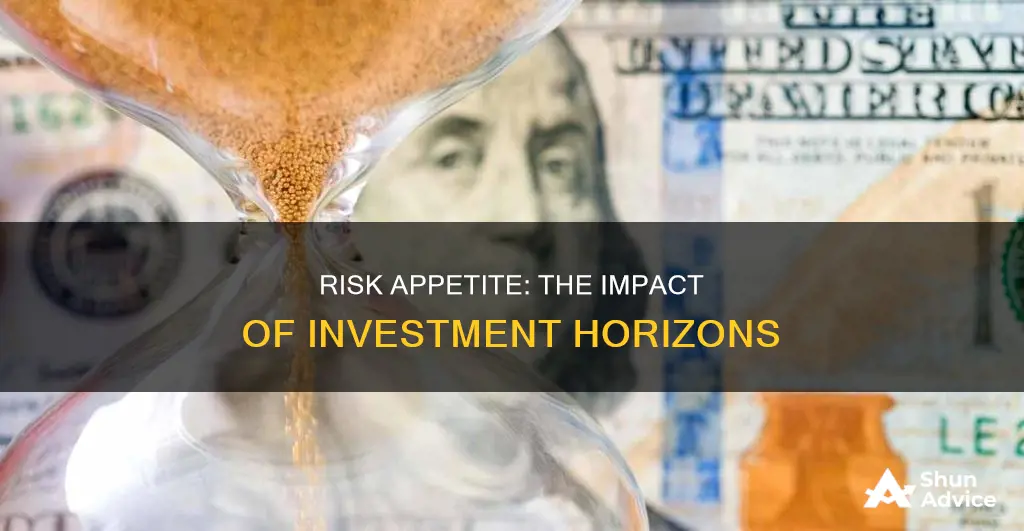
An investment time horizon is the period of time an investor expects to hold an investment before needing the money back. The longer the time horizon, the more aggressive an investor can be with their portfolio, and the more risk they can take on. This is because the longer the time horizon, the more time there is for the investment to recover from any short-term downturns.
However, the relationship between time horizon and risk is not always straightforward. Research has shown that people's perceptions of risk can be influenced by a variety of factors, including their personality, life circumstances, and goals. For example, younger investors generally have a higher risk tolerance because they have a longer time horizon and can recover from short-term losses. On the other hand, investors approaching retirement typically have a lower risk tolerance as they seek to protect their capital.
Additionally, factors such as income, investment experience, and economic conditions can also impact an investor's risk tolerance. A steady income stream, for instance, can provide a safety net that allows investors to take on more risk.
Ultimately, each investor needs to carefully evaluate their own goals, risk tolerance, and investment timeline to determine the optimal balance of risk and reward for their portfolio.
| Characteristics | Values |
|---|---|
| Investment horizon | The period of time one expects to hold an investment until they need the money back. |
| --- | --- |
| Investment goals | Saving for a down payment on a house, for college, or for retirement. |
| Investment strategies | Stocks (riskier) and bonds (less risky). |
| Risk | The chance that an investment's actual gains will differ from an expected outcome or return. |
| Risk tolerance | The degree of variability in investment returns that an investor is willing to withstand. |
| Risk management strategies | Diversification, hedging, standard deviation, beta, Value at Risk (VaR), and the Capital Asset Pricing Model (CAPM). |
What You'll Learn
- The longer the investment horizon, the more aggressive the investor can be
- Younger investors have a higher risk tolerance
- Risk tolerance is subjective and varies from person to person
- Risk can be reduced using diversification and hedging strategies
- The longer the investment horizon, the lower the probability of loss

The longer the investment horizon, the more aggressive the investor can be
An investment time horizon is the length of time an investor expects to hold an investment before they need their money back. The longer the time horizon, the more aggressive an investor can be with their portfolio. This is because the longer the time horizon, the more time there is for the investment to recover from any short-term downturns.
Younger investors tend to have a longer time horizon, and therefore a higher risk tolerance. They are more likely to invest in higher-risk assets, such as stocks and real estate, to maximise returns over time. As investors approach retirement, their risk tolerance decreases as protecting their capital becomes a higher priority. Retired investors often shift their portfolios towards lower-risk investments, such as bonds, annuities, and other income-generating assets, to preserve their savings.
The length of an investment horizon will determine the types of investment products that are most suitable for the investor's goals. Generally, investors seek stable assets for short-term investing and are more willing to accept riskier investments for longer-term investment horizons.
When it comes to assessing the probability of loss, history shows that the longer the investment horizon, the lower the probability of loss. For example, if you invest in the US stock market for a year, there is a roughly 25% chance that your investments will decline in value by the end of that year. However, if you invest for a ten-year period, those odds drop to less than 5%.
It is important to note that while longer investment horizons are generally associated with higher risk tolerance, an investor's risk tolerance is also influenced by factors such as income, financial stability, life circumstances, and personal goals. Each investor has a unique risk profile, and it is crucial to carefully evaluate your own goals, investment timeline, and risk tolerance before making any investment decisions.
Exploring Careers in Investment Management: Diverse Opportunities
You may want to see also

Younger investors have a higher risk tolerance
Younger investors are generally more tolerant of risk. This is largely due to their longer investment time horizon, which refers to the period of time an investor expects to hold an investment before needing to withdraw the funds. A longer time horizon means there is a greater potential for recovery from short-term market fluctuations and losses.
Younger investors typically have more working years ahead of them to earn, save, and invest, and they are less likely to need their portfolios for everyday expenses. This means they can afford to take more risks and have a higher capacity to tolerate large negative swings in their portfolios.
As investors get closer to retirement, their risk tolerance tends to decrease. Protecting their capital and ensuring a stable income stream become higher priorities. Retired investors often shift their portfolios towards lower-risk investments, such as bonds, annuities, and other income-generating assets, to preserve their savings.
The impact of time horizons on risk tolerance can be seen in the context of different investment goals. For example, saving for retirement is typically considered a long-term investment goal, while saving for a down payment on a house is usually a short-term goal. With a longer time horizon, investors can be more aggressive in their investment choices and take on more risk, expecting greater returns over time. Conversely, with a shorter time horizon, investors tend to favour more conservative, less risky investments to protect their capital.
It's important to note that while age is a factor in risk tolerance, it is not the sole determinant. Other factors, such as financial status, income, and personal comfort, also play a role in an individual's risk tolerance. Additionally, as investors gain more experience and knowledge about the market, their risk tolerance may also evolve.
Diverse Investment Portfolios: Strategies, Risks, and Benefits
You may want to see also

Risk tolerance is subjective and varies from person to person
An individual's risk tolerance is influenced by factors such as age, income, investment experience, and personality traits. Younger investors generally have a higher risk tolerance because they have a longer time horizon before accessing their investment funds, allowing for potential recovery from short-term market fluctuations and losses. As investors approach retirement, their risk tolerance typically decreases as protecting their capital and ensuring a stable income stream become higher priorities.
Income and financial stability also play a role in risk tolerance. A steady income stream provides a safety net, allowing individuals to invest in higher-risk, higher-reward assets without jeopardizing their financial well-being. Conversely, those with lower or less predictable incomes may prefer safer investments to preserve capital and avoid financial strain.
Life circumstances and personal goals also impact risk tolerance. Significant life events, such as getting married or starting a family, may shift an individual's focus towards financial security and stability, leading them to favour more conservative investments. On the other hand, receiving a financial windfall might increase their capacity and willingness to take on more risk.
Investment experience is another factor. Seasoned investors are typically more comfortable with market volatility and complex investment products, having navigated through various market cycles and developed risk management strategies. In contrast, novice investors may have a lower risk tolerance due to a lack of familiarity with the market, and the fear of potential losses may lead them to favour conservative investments.
Psychological factors also come into play. Naturally risk-averse individuals prefer safer investments that offer stability, while those with a risk-seeking personality are more comfortable with volatility and are willing to accept it in pursuit of higher returns. However, balancing this trait with prudent risk management is essential to avoid excessive losses that could jeopardise financial goals.
Economic and market conditions can also influence risk tolerance. In a bull market, with rising stock prices and economic optimism, investors might be more willing to invest in higher-risk assets, expecting continued growth. On the other hand, during bear markets, risk tolerance might decrease as prices fall and market sentiment becomes pessimistic.
Ultimately, each investor has a unique risk profile that determines their willingness and ability to withstand risk. By understanding their own risk tolerance, investors can make more informed decisions about their investment strategies and achieve their financial goals while staying within their comfort zone.
Understanding the Investment Management Division of the DOT
You may want to see also

Risk can be reduced using diversification and hedging strategies
An investment time horizon is the period of time an investor expects to hold an investment before they need the money back. Generally, the longer the time horizon, the more aggressive an investor can be in their portfolio. This is because a longer time horizon allows for the potential recovery from short-term market fluctuations and losses.
Now, let's discuss how risk can be reduced using diversification and hedging strategies:
Diversification Strategies
Diversification is a risk management technique that involves spreading investments across various assets, industries, and geographies. By not putting all your eggs in one basket, you reduce the impact of any single investment's poor performance. Here are some ways to achieve diversification:
- Asset Allocation: Diversify your portfolio by investing in different asset classes such as stocks, bonds, real estate, cash equivalents, and commodities. This helps spread risk and ensures that not all your investments are affected by market downturns.
- Mutual Funds and ETFs: Mutual funds and exchange-traded funds (ETFs) offer instant diversification by providing exposure to a basket of securities. These funds are tailored to various risk levels, allowing moderate investors to seek a mix of security and growth.
- Dividend-Paying Stocks: Stocks that pay regular dividends offer both income and growth potential. They tend to be less volatile than non-dividend-paying stocks, making them suitable for moderate-risk investors.
Hedging Strategies
Hedging involves making investments that offset the risk of your primary investments. Here are some common hedging strategies:
- Options: Buying put options protects against the risk of big losses. For example, if you believe the value of your shares will decrease, you can buy a put option that gives you the right to sell your shares at a specific price (strike price).
- Volatility Index (VIX): The VIX measures the implied volatility of the S&P 500 index options. It is often used as a hedge during periods of increased market volatility. When the VIX rises, you can use exchange-traded funds (ETFs) or options to go long on the VIX.
- Safe-Haven Assets: Invest in assets that tend to hold or increase their value during economic downturns or volatile markets. Examples include gold, strong currencies like the US dollar, and government bonds.
- Forward Contracts and Futures Contracts: These derivatives allow you to buy or sell an asset at a specified price on a future date. They are useful when you expect price volatility or changes in supply and demand for an asset.
- Pair Trading: This strategy involves pairing long and short positions in two stocks with a long-term positive correlation. You identify a discrepancy in the correlation and then go long on the undervalued asset and short on the overvalued one.
- Delta Hedging: This complex strategy is used by accredited investors and investment banks. It involves neutralizing or reducing the change of an option's price in relation to the underlying asset's price.
By employing these diversification and hedging strategies, investors can reduce their exposure to risk and protect their portfolios from significant losses. However, it's important to note that hedging strategies may vary in effectiveness depending on individual circumstances, and they do not guarantee complete protection from losses.
Understanding the Portfolio Investment Process: A Comprehensive Guide
You may want to see also

The longer the investment horizon, the lower the probability of loss
When it comes to investing, risk is an inherent part of the process. The longer one's investment horizon, or time horizon, the lower the probability of loss. This is because, over longer periods, financial markets tend to behave in a more predictable manner, whereas in the short term, they are extremely unpredictable.
For example, investing in the S&P 500 for a day gives you barely better odds than a coin toss. However, if you invest for five years, your chances of earning a return increase to 90%. The longer the time horizon, the more time there is to recover from any short-term downturns. This is similar to playing roulette: if a player only bets once, the casino owner's odds are not great. But if the player bets a thousand times, the small odds in the casino's favour virtually guarantee a profit.
The length of the investment horizon also affects the type of investments one can make. The longer the horizon, the more aggressive or riskier the portfolio can be. This is because there is more time to recover from any potential losses. For instance, younger investors typically have a higher risk tolerance because they have a longer time horizon and can recover from short-term market fluctuations. As investors approach retirement, their risk tolerance decreases as capital preservation and stable income become higher priorities.
Additionally, the longer the investment horizon, the more time there is for compounding to occur. Compounding refers to the process of generating profits from previous profits, and it can significantly increase overall returns. This is why it is important to start saving for retirement early: even a small investment now can generate high returns if it has several decades to grow.
While a longer investment horizon reduces the risk of loss, it does not eliminate it. There is still a chance of suffering a large loss, and the future may be very different from the past. For example, US stocks have been the best-performing asset over the past few decades, but this may not be the case in the future. Additionally, long-term investing goes against human instincts, as it requires patience, discipline, and the ability to avoid impulsive decisions.
Silver Investment Guide: Buying Silver in India
You may want to see also
Frequently asked questions
The longer the investment horizon, the more aggressive an investor can be in their portfolio, and vice versa. This is because the longer the time horizon, the more time there is to recover from short-term market fluctuations and losses.
Short-term investments are more susceptible to market risk and volatility risk. They are also more likely to be affected by speculative behavior, market crashes, or other world events.
Younger investors generally have a higher risk tolerance because they have a longer time horizon before accessing their investment funds. As investors approach retirement, their risk tolerance typically decreases because protecting their capital and ensuring a stable income stream become higher priorities.







